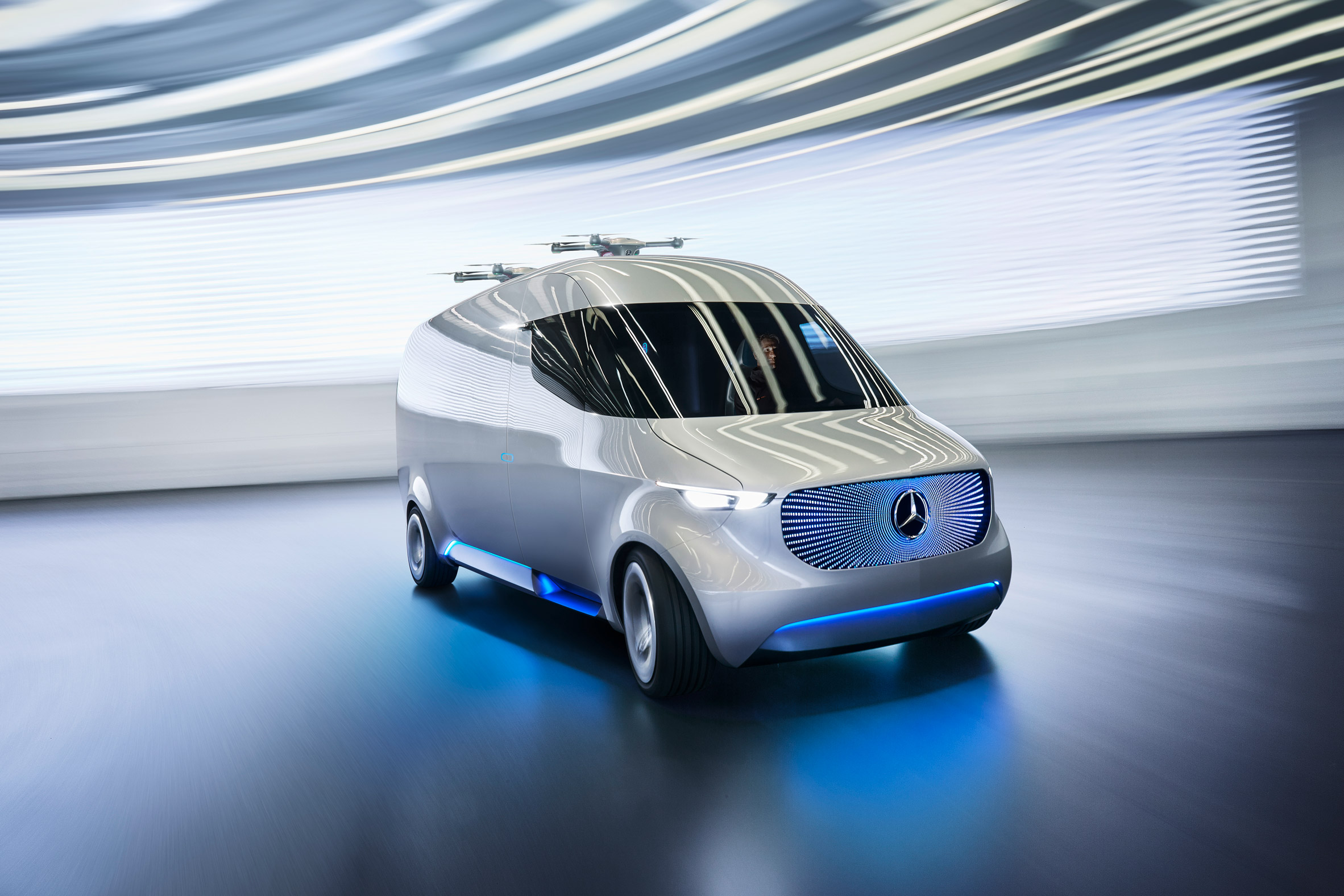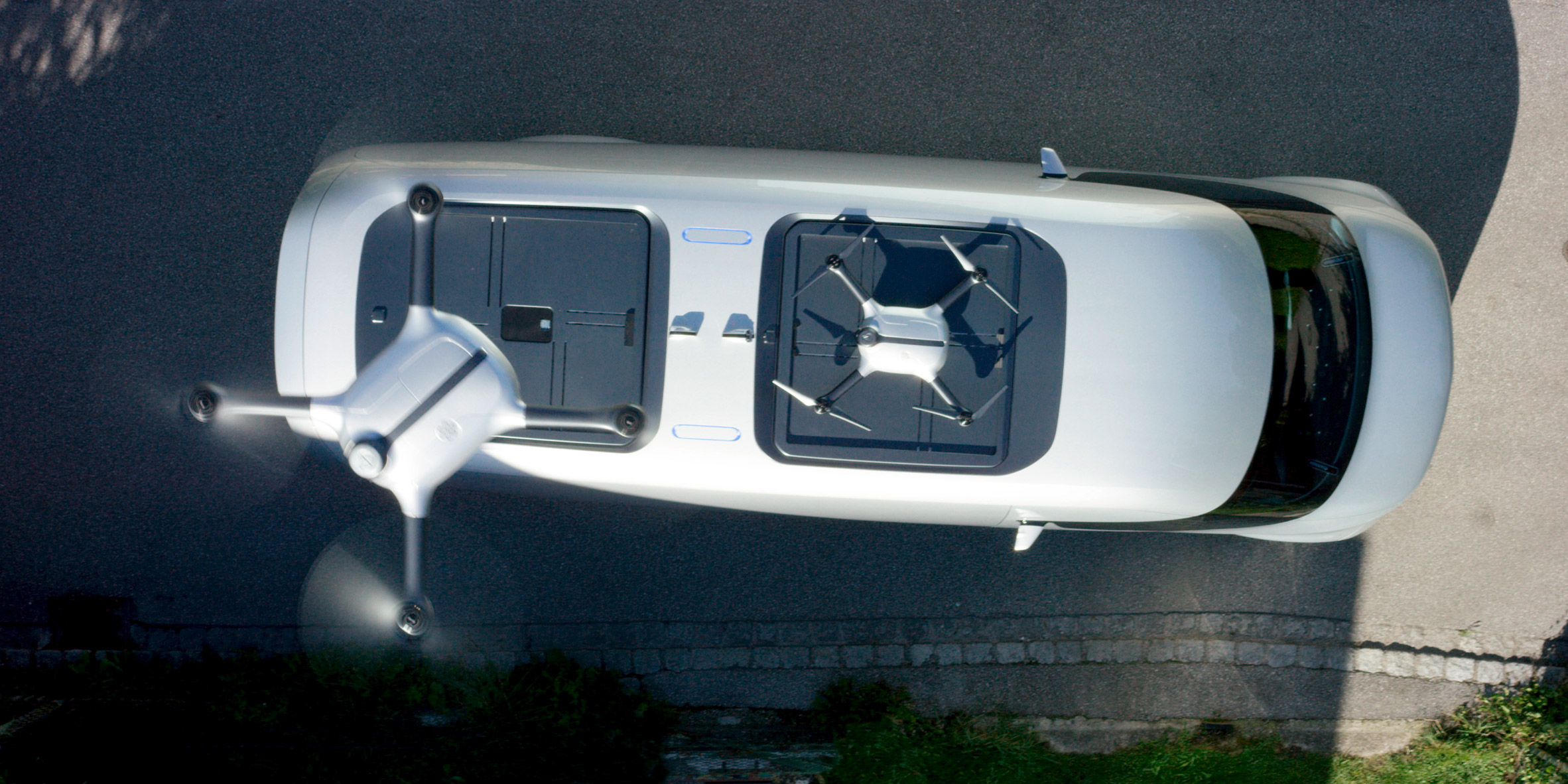Just one more mile to go…

Tired of searching for your purchases on your building's common area? Mercedes-Benz, the German luxury automaker (who could imagine?), is set to disrupt the delivery industry and get those packages where you want them and when you want them.
Marathoners say the race doesn’t start until the last 10km: that’s when our bodies (trying to look good here since I couldn’t ever reach that point) have basically consumed our carb deposits and we have no energy left to run. Likewise, in logistics, a huge burden is put on what the industry refers to as the “last-mile”.
The last-mile is, more generally, the last leg of the supply chain, which, experts say, accounts for 28% of total cost to move goods [i]. Why’s that? Well, first it’s in this stage that products are generally unbundled, taken from inside containers or pallets, and individualized in their own packages. Second, last-mile deliveries involve either moving in urban areas, and facing congestion or safety issues and restrictions, or in remote ones, where paved roads are non-existent or which may have suffered from disasters. Finally, this is generally the sole point of contact between supplier and consumer and where a lot of friction may occur as companies face inquiries and requests on how products should be delivered (“don’t ring the doorbell” is an example some of us may relate to). [ii]
A historic problem in logistics, therefore, the last-mile has faced even more challenges with the growth of e-commerce. As Rick Rover, Senior Vice President of Operations for Streamlite, an Atlanta-based shipping solutions company, puts it: “The supply chain’s been extended [because] of changes in consumer buying patterns. As people turn to the Web to purchase lighter-weight, less-expensive goods, and do so more frequently, the supply chain extends right to the mailbox.” [i]
Mercedes-Benz, the luxury auto-maker we all dream about, has decided to act on this front. The company partnered with American drone manufacturer, Matternet, to create a concept car they call the Vision Van. Here’s a picture of this beauty so you all can better visualize what I’m talking about:

The first feature that stands out on the vans are the rooftops, which serve as a launch and landing pad for Matternet’s M2 drones, autonomous air vehicles that can pick up and carry a package of 4.4 pounds across 12 miles of sky on a single battery charge. [iii]

But the evolutions are countless, spanning from the design to the software that organizes deliveries:
- This is an electric vehicle (“wait, this so last week!”): no, seriously, this is a big competitive advantage for the Vision Van, since delivery vehicles are usually noisy, big pollutants, riding into residential areas.
- The van has an integrated routing system (like Uber’s – “see, now you are in the right track, Ricardo…”) and the rear wall of the van’s cabin will have an information terminal which provides relevant information for the delivery process, such as instructions on where to place a package.
- No human labor is used in putting packages in the truck: an automated material handling system will load packages into racks. Vision Van’s software also includes miniature delivery management system that understands which parcels are in which rack slots, and which address that package needs to be delivered to. As drivers arrive at the address, the right packages are automatically presented to them. Even the van door will automatically open once the package is dispensed, thus eliminating the wasted time used in searching for products in the back of the van. [iv]
- The drone system itself: this is amazing, and sounds like coming off a Jetsons cartoon (“wait, is that still a meaningful comparison?”), but company representatives affirm that the drones can work with the van’s operating and cloud-based systems to load items from the van to the drone automatically, with the help of the robotic shelving systems described. The drones are, therefore, reloaded without human intervention. The same process occurs in swapping their batteries. [v] The system can also work in two ways: either the drone launches from the Vision Van with a payload to a final destination that is, for some reason, inaccessible (or more strenuously accessed) by the van or driver, or the drones can fly a package from a warehouse or distribution center to a van, in which case the driver could pick it up and deliver it to the hands of the customer. [iii]
https://www.youtube.com/watch?v=ve63xdzc3hg
Hence, there’s no doubt that Vision Van will make that last-mile shorter. The problem the company is facing, however, is on the regulatory front. The FAA, United States’ Federal Aviation Administration, for instance, limits drone use to visual line of sight, thus making their use in order fulfillment nearly impossible for the time being. [v] With such a disruptive product, Mercedes should focus its efforts on convincing lawmakers that the pros of an efficient, clean form of delivery are substantially greater than the threat to privacy in a world dominated by Facebook. That may very well be the one last mile the company must overcome to win this race.
(799 words)
[i]: http://www.supplychaindigital.com/logistics/3355/The-last-mile-problem-by-Parcel2Go
[ii]: http://bringg.com/blog/insights/4-challenges-of-last-mile-delivery-for-ecommerce/
[v]: https://www.dezeen.com/2016/09/09/mercedes-benz-vision-van-electric-drones-automated-prototype/



Compared to all the hype that the development by Amazon of drone delivery systems is getting, I appreciate the incremental step that this approach is taking in improving the last leg of the personal shipping process. As far as regulations go, I would be less afraid that the government will not adapt to such technology. While it will most likely take more time than most would prefer, I feel that the significant improvement in reliability and efficiencies will outweigh and political apprehension that may be currently hindering progressive policy. For example, laws and policy surrounding privacy, regardless of all the controversy surrounding NSA hacking, have had to drastically shift to address the new technology. This is particularly pronounced in the privacy realm of patient data, as many healthcare providers see the benefit of coagulating data for probabilistic treatment determinations. The government has to make exceptions for commercial purposes to rules such as the current FAA regulations you mentioned.
Thanks for the post Ricardo! I had no idea that companies like Mercedes are working on such projects! I knew that Mercedes had a commercial vehicle arm but the idea of adding features that would make the use of Mercedes vehicles more attractive for delivery workers is quite an extraordinary implementation of some of the stuff we have learnt in TOM. I do see the regulatory challenges you mentioned in your post. It’s not so much that the government will not adapt, they will eventually. The question is how long will they take to update their rulebooks!
I think this is a great marketing strategy for Mercedes. Like IBM’s assault on Jeapody, Mercedes’ attack on last-mile delivery sends a strong signal to the market – Mercedes is a leader in technology, reliable, and will transport anything (including you and your stuff) in style. Given Mercedes is not looking to publish incremental research papers on its technology, I think this moonshot attempt is the right goal for the company.
While it is pretty obvious that this application cannot reasonably replace all of last-mile delivery by trucks and people (because of costs and reliability issues resulting from bad weather and other externalities), I think it will be interesting to look into what alternative applications this can have in different industries. Who knows, but maybe babies will now be delivered by drones rather than stalks some day.
Hey Ricardo, great post. I’m curious about the response from the unions on the tech development here, especially those working for the major carriers (e.g. the Teamsters). Has there been pushback on the rollout of the tech given the inevitable reduction in workforce that will occur? What can the companies involved do to cross-train their employees? I guess a lot will depend on how much human intervention is needed in the supply chain loop but seems like a potential issue in the short term in addition to regulation.
Very interesting read! Mercedes has always been a leader in technology and for decades the Company has designed some of the most innovative vehicles on the market. When I think of Mercedes, I think sexy, fast, expensive, stylish, cool, elite, and so on. As a result, I am not surprised that even though they are solving a not so sexy problem, the Vision Van still embodies the core design characteristics of a Mercedes. The best or nothing.
On the surface, this looks like a great idea but I worry that implementation will be very challenging. First, are the regulatory challenges that you addressed in your post. How long will it take for regulators to accept this concept? And even if they do, will the average consumer be receptive to drones flying onto their properties given potential threats (think bombs etc) and just how much this technology disrupts the traditional mailman that has been around for centuries. Lastly, I worry about the mailman, how many jobs will be lost if this technology is successful, will unions be receptive to this?
Very interesting read Ricardo. One question that I contemplated when reading this was regarding the Uber-like routing system/implementation of the actual driving. If the vehicles follow a predetermined route, do the cars have the ability to sense and avoid unexpected obstacles, like a passing bird or a recently fallen branch or other drivers on the road?
Further, I am interested in learning more about the economics of this cargo-bot delivery system. What will be the capex investment for this system on Mercedes end? Also with more consumers looking for customized shipping options, can this variability in delivery options inflate costs for this method of delivery for Mercedes? Will they pass this cost on to the consumer? Consumers tend to be very sensitive about their shipping prices!
Thank you, Ricardo. This is very interesting. It is very interesting to see it as an integration between current delivery models and disruptive technologies that will change the market. Using automobiles as drone launching pads might be very effective in reducing overall costs for deliveries since you can leverage automobiles when they are the most efficient, at mid-range distances, and leverage drones for individual deliveries, leaving products at your doorstep in record time and thus freeing up the driver’s time, which can reduce overall cycle time.
This makes me think about other transitional technologies, such as hybrid cars. As electrification is a non-stop trend, current internal combustion technology can be useful to optimize motor efficiency while increasing range, taking the best of both worlds.
Wow, cool post! Solving distribution challenges as consumers increasingly move their purchases online will certainly be one of the most important challenges of the next decade for retailers. I love how Mercedes is automating the entire delivery process. The automatic presentation of packages should reduce human error in delivery. It never occurred to me that companies would consider using drones to help deliver purchases. Given drone-use is in its infancy, I wonder what the regulatory environment for drone use will look like in the future and whether (as you point out) legislation will limit the extent to which drones can be used.